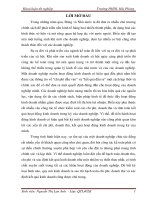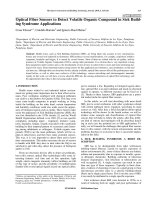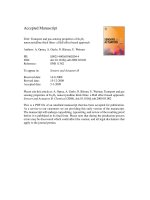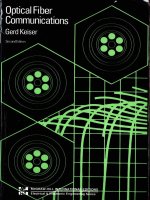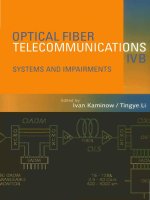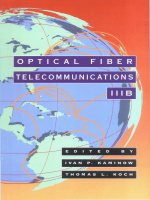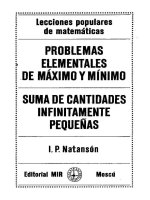kaminow, i. p. (1997). optical fiber telecommunications iii-b
Bạn đang xem bản rút gọn của tài liệu. Xem và tải ngay bản đầy đủ của tài liệu tại đây (25.19 MB, 534 trang )
t-
OPTICAL
FIBER'
TELECOMMUNICATI
EDITED
IVAN
P.
KAMINOW
THOMAS
L.
KOCH
I
I
I
OPTICAL FIBER
TELECOMMUNICATIONS IIIB
OPTICAL FIBER
TELECOMMUNICATIONS IIIB
Edited
by
IVAN
P.
KAMINOW
Lucent Technologies, Bell Laboratories
Holmdel, New Jersey
THOMAS
L.
KOCH
Lucent Technologies, Bell
Laboratories
Holmdel, New Jersey
@
ACADEMIC
PRESS
San
Diego
London Boston
New
York Sydney Tokyo Toronto
This book is printed
on
acid-free paper.
@
Copyright
0
1997 by Lucent Technologies
All rights reserved.
No part of this publication may be reproduced or transmitted in any form
or
by any means,
electronic
or mechanical, including photocopy, recording,
or
any information storage and
retrieval system, without permission in writing from the publisher.
ACADEMIC PRESS
525 B Street, Suite 1900, San Diego, CA 92101-4495, USA
1300 Boylston Street, Chestnut Hill, MA 02167, USA
Academic Press Limited
24-28 Oval Road, London NW1 7DX, UK
Library
of
Congress Cataloging-in-Publication Data
Optical fiber telecommunications I11
/
[edited by] Ivan P. Kaminow, Thomas L. Koch.
Includes bibliographical references and index.
1. Optical communications. 2. Fiber optics. I. Kaminow, Ivan P. 11. Koch, Thomas
L.
p. cm.
ISBN 0-12-395170-4 (v. A)
-
ISBN 0-12-395171-2 (v. B)
TK5103.59.H3516 1997 96-43812
621.382'75-dc20
CIP
Printed in the United States
of
America
00
01 MP 9
8
7
6
5
4
3 2
For our dear grandchildren:
Sarah, Joseph, Rafael, Nicolas, Gabriel, Sophia, and Maura
-
IPK
For Peggy, Brian, and Marianne
-
TLK
Contents
Con
trib
ut0
rs
xi
Chapter
1
Overview
Ivan
P.
Karninow
History
The New Volume
Survey
of
Volumes IIIA and
IIIB
References
Chapter
2
Erbium-Doped Fiber Amplifiers
for
Optical Communications
John
L.
Zyskind, Jonathan
A.
Nagel, and Howard
D.
Kidorf
Introduction
Properties of EDFAs
Terrestrial Applications for EDFAs
Submarine Systems
Optical Amplifiers for Analog Video Transmission
Optical Amplifiers for Optical Networking
Conclusions
References
Chapter
3
‘Transmitter and Receiver Design for Amplified
Lightwave
Systems
Daniel
A.
Fishrnan and
B.
Scott
Jackson
Introduction
Design Intricacies of Laser Transmitters
Receivers for Optically Amplified Systems
Systems Performance Metrics
Multiple-Wavelength Systems
vii
1
1
2
3
12
13
13
14
28
42
57
60
63
63
69
69
74
84
94
99
viii
Contents
Provisions for Performance Monitoring in Long
References
Amplified Systems
Chapter
4
Laser Sources for Amplified and
WDM
Lightwave Systems
T.
L.
Koch
Introduction
Low-Chirp Transmission Sources
WDM Sources
Con
c
1
us
i
o
n
s
References
Chapter
5
Advances
in
Semiconductor
Laser
Growth
and
Fabrication
Technology
Charles
H.
Joyner
Introduction
New Sources and Growth Apparatus
Band Structure Engineering by Means of Strained Multiple
Selective Area Growth
Selective Area Etching
Beam Expanded Lasers
Conclusion
References
Quantum Wells
Chapter
6
Vertical-Cavity Surface-Emitting Lasers
L.
A. Coldren and
B.
J.
Thibeault
Introduction
Structures
Design Issues
Growth and Fabrication Issues
Integration: Photonic
and
Optoelectronic
Applications
References
101
108
115
115
115
132
158
159
163
163
163
164
179
187
188
193
193
200
200
201
219
235
243
251
258
Contents
ix
Chapter
7
Optical Fiber Components and Devices
Alice
E.
White and Stephen
G.
Grubh
Fiber Amplifiers and Related Components
Applications
of
Fiber Gratings
High-Power Fiber Lasers and Amplifiers
Up-Conversion Fiber Lasers and Amplifiers
References
Chapter
8
Silicon Optical
Bench
Waveguide Technology
Yuan
P.
Li
and
Charles
H. Henry
Introduction
Materials and Fabrication
Design
Transmission Loss
Couplers and Splitters
Mach-Zehnder and Fourier Filter Multiplexers
Array Waveguide Devices
Bragg Reflection
Wavelength and Polarization Control
Amplification
in
Erbium-Doped Waveguides
Integrated Optical Switches
Hybrid Integration
Conclusion
References
Chapter
9
Lithium Niobate Integrated Optics: Selected
Contemporary Devices and System Applications
Fred Heismann, Steven K. Korotky, and
John
J.
Veselka
Introduction
High-speed Phase and Amplitude Modulators and Switches
Electrooptic Polarization Scramblers and Controllers
Electrooptic and Acoustooptic Wavelength Filters
Summary and Conclusions
References
267
268
276
289
302
310
319
310
322
328
335
339
345
35
1
358
36
1
364
365
367
369
370
377
377
381
420
442
450
45
1
x
Contents
Chapter
10
Photonic Switching
Edrnond
J.
Murphy
Introduction
Optical Switching Overview
Technology Advances
Device Demonstrations
System Demonstrations and Advances
Summary and Comments
References
463
463
464
469
480
490
493
494
Index
503
Contributors
L.
A.
Coldren
(Ch.
6),
Department
of
Electrical and Computer Engineering.
University of California, Santa Barbara, California 93106
Crawfords Corner Road, Holmdel, New Jersey 07733
Daniel
A.
Fishman
(Ch. 3), Lucent Technologies, Bell Laboratories, 101
Stephen
G. Grubb*
(Ch. 7), Lucent Technologies, Bell Laboratories,
600
Fred Heismann
(Ch. 9), Lucent Technologies, Bell Laboratories, 101 Craw-
Mountain Avenue, Murray Hill, New Jersey 07974
fords Corner Road, Holmdel, New Jersey 07733
Mountain Avenue, Murray Hill. New Jersey 07974
Charles
H.
Henry
(Ch. S), Lucent Technologies, Bell Laboratories, 700
B.
Scatt Jack9on
(Ch. 3), AT&T Laboratories,
101
Crawfords Corner Road,
Room 3D-418, Holmdel, New Jersey 07733
Charles
H.
Joyner
(Ch.
5),
Lucent Technologies, Bell Laboratories, 791
Holmdel-Keyport Road, Room
HOH
M-229D, Holmdel, New Jer-
sey 07733
Holmdel-Keyport Road, Holmdel, New Jersey 07733
Ivan
P.
Kaminow
(Ch.
l),
Lucent Technologies, Bell Laboratories, 791
Howard
D.
Kidorf
(Ch.
2),
AT&T Submarine Systems Inc., Roberts Road,
Holmdel, New Jersey 07733
Thomas
L.
Koch
(Ch. 4), Lucent Technologies, Bell Laboratories, 101
Crawfords Corner Road. Room 4E-338, Holmdel, New Jersey 07733
Steven K. Korotky
(Ch. 9), Lucent Technologies, Bell Laboratories,
101
Crawfords Corner Road, Room HO 4F-313, Holmdel, New Jersey
07733
*
Present address:
SDL,
Inc
80
Rose
Orchard Way. San Jose, California
95134
Xi
xii
Contributors
Yuan
P.
Li
(Ch.
8),
Lucent Technologies, Bell Laboratories,
2000
Northeast
Expressway, Norcross, Georgia 30071
Edmond
J.
Murphy
(Ch. lo), Lucent Technologies, Bell Laboratories, 9999
Hamilton Boulevard, Breinigsville, Pennsylvania 18031
Jonathan A. Nagel
(Ch.
2),
AT&T Laboratories-Research, Crawford Hill
Laboratory, 791 Holmdel-Keyport Road, Room L-137, Holmdel, New
Jersey 07733
B.
J.
Thibeault
(Ch.
6),
Department of Electrical and Computer Engineer-
ing, University of California, Santa Barbara, California 93106
John
J.
Veselka
(Ch. 9), Lucent Technologies, Bell Laboratories, 101 Craw-
fords Corner Road, Holmdel, New Jersey 07733
Alice
E.
White
(Ch. 7), Lucent Technologies, Bell Laboratories, 600 Moun-
tain Avenue, Murray Hill, New Jersey 07974
John
L.
Zyskind
(Ch.
2),
Lucent Technologies, Bell Laboratories, Crawford
Hill Laboratory, 791 Holmdel-Keyport Road, Holmdel, New Jersey
07733
Ivan
P.
Kaminow
A
7&
T
Bell
Laboratories
(retired),
Eiolmdel,
New Jerwv
Optical Fiber Telecommunications.
edited by Stewart E. Miller and Alan
G.
Chynoweth, was published in
1979,
at the dawn of the revolution in
lightwave telecommunications. This book was a stand-alone volume that
collected all available information for designing a lightwave system. Miller
was Director
of
the Lightwave Systems Research Laboratory and, together
with Rudi Kompfner, the Associate Executive Director, provided much
of the leadership at the Crawford Hill Laboratory
of
Bell Laboratories:
Chynoweth was an Executive Director in the Murray Hill Laboratory,
leading the optical component development. Many research and develop-
ment (R&D) groups were active at other laboratories in the United States,
Europe, and Japan. The book, however, was written exclusively by Bell
Laboratories authors, although it incorporated the global results.
Looking back at that volume,
I
find it interesting that the topics are
quite basic but in some ways dated. The largest group of chapters covers
the theory, materials, measurement techniques, and properties
of
fibers
and cables
-
for the most part, multimode fibers. A single chapter covers
optical sources, mainly multimode AlGaAs lasers operating in the
800-
to
900-nm band. The remaining chapters cover direct and external modulation
techniques, photodetectors and receiver design, and system design and
applications. Still, the basic elements for the present-day systems are there:
low-loss vapor-phase silica fiber and double-heterostructure lasers.
Although a few system trials took place beginning in
1979,
it required
several years before a commercially attractive lightwave telecommunica-
tions system was installed in the United States. This was the AT&T North-
east Corridor System operating between New York and Washington, DC.
1
OPTICAI. FIBER TELECOMMUNICATIONS
VOI
L'ME
IIlB
2
Ivan
P.
Kaminow
that began service in January 1983, operating at a wavelength of
820
nm
and a bit rate of 45 Mb/s in multimode fiber. Lightwave systems were
upgraded in 1984 to 1310 nm and about
500
Mb/s
in single-mode fiber in
the United States, as well as in Europe and Japan.
Tremendous progress was made during the next few years, and the choice
of lightwave over copper for all long-haul systems was ensured. The drive
was to improve performance, such as bit rate and repeater spacing, and to
find other applications. A completely new book,
Optical Fiber Telecommu-
nications
ZZ
(OFT
IZ),
edited by Stewart
E.
Miller and me, was published
in 1988 to summarize the lightwave design information known at the time.
To broaden the coverage, we included some non-Bell Laboratories authors,
including several authors from Bellcore, which had been divested from Bell
Laboratories in 1984 as a result of the court-imposed “Modified Final
Judgment.” Corning, Nippon Electric Corporation, and several universities
were represented among the contributors. Although research results are
described in
OFT
ZZ,
the emphasis is much stronger on commercial applica-
tions than in the previous volume.
The early chapters of
OFTZZ
cover fibers, cables, and connectors, dealing
with both single- and multimode fiber. Topics include vapor-phase meth-
ods for fabricating low-loss fiber operating at 1310 and 1550 nm, under-
standing chromatic dispersion and various nonlinear effects, and designing
polarization-maintaining fiber. Another large group of chapters deals with
a wide geographic scope of systems for loop, intercity, interoffice, and
undersea applications.
A
research-oriented chapter deals with coherent
systems and another with possible local area network applications, including
a comparison of time-division multiplexing (TDM) and wavelength-division
multiplexing (WDM) to effectively utilize the fiber bandwidth. Several
chapters cover practical subsystem components, such as receivers and trans-
mitters, and their reliability. Other chapters cover the photonic devices, such
as lasers, photodiodes, modulators, and integrated electronic and integrated
optic circuits, that compose the subsystems. In particular, epitaxial growth
methods for InGaAsP materials suitable for 1310- and 1550-nm applica-
tions, and the design of high-speed single-mode lasers are discussed.
The
New
Volume
By
1995,
it was clear that the time for a new volume
to
address the recent
research advances and the maturing of lightwave systems had arrived. The
contrast with the research and business climates of 1979 was dramatic.
System experiments of extreme sophistication were being performed
1.
Overview
3
by building on the commercial and research components funded for
a
proven multibillion-dollar global industry. For example,
10,000
km of high-
performance fiber was assembled in several laboratories around the world
for
NRZ
(non-return-to-zero), soliton, and WDM system experiments. The
competition in both the service and hardware ends of the telecommunica-
tions business was stimulated by worldwide regulatory relief. The success
in the long-haul market and the availability of relatively inexpensive compo-
nents led to a wider quest for other lightwave applications in cable television
and local access network markets. The development of the diode-pumped
erbium-doped fiber amplifier (EDFA) played a crucial role in enhancing
the feasibility and performance
of
long-distance and WDM applications.
In
planning the new volume, Tom Koch and
I
looked for authors to
update the topics
of
the previous volumes, such as fibers, cables, and laser
sources. But
a
much larger list of topics contained fields not previously
included, such as
SONET
(synchronous optical network) standards,
EDFAs, fiber nonlinearities, solitons, and passive optical networks
(PONS).
Throughout the volume, erbium amplifiers, WDM, and associated compo-
nents are common themes.
Again, most of the authors come from Bell Laboratories and Bellcore,
where much of the research and development was concentrated and where
we knew many potential authors. Still, we attempted to find
a
few authors
from elsewhere for balance. Soon after laying out the table of contents and
lining up the authors, however,
a
bombshell and a few hand grenades
struck. AT&T decided to split into three independent companies, Bellcore
was put up for sale, and several authors changed jobs, including Tom Koch
and
I.
The resulting turmoil and uncertainty made the job of getting the
chapters completed tougher than for the earlier volumes, which enjoyed
a
climate of relative tranquillity.
In the end, we assembled a complete set of chapters for
Optical Fiber
Telecommunications
III,
and can offer another timely and definitive survey
of the field. Because of the large number of pages, the publisher recom-
mended separating the volume into two sections, A and B. This format
should prove more manageable and convenient for the reader. The chapters
are numbered from Chapter
1
in each section, with this Overview repeated
as Chapter
1
in both sections
A
and B to accommodate users who choose
to buy just one book.
Survey
of
Volumes IIIA and IIIB
The chapters of Volumes
IIIA
and
IIIB
are briefly surveyed as follows in
an attempt to put the elements of the book in context.
4
Ivan
P.
Kaminow
VOLUME
IIIA
SONET
and
ATM
(Chapter
2)
The market forces of deregulation and globalization have driven the need
for telecommunications standards. Domestically, the breakup of AT&T
meant that service providers and equipment suppliers no longer accepted
de facto
standards set by “Ma Bell.” They wanted to buy and sell equipment
competitively and to be sure that components from many providers would
interoperate successfully. The globalization of markets extended these
needs worldwide. And the remarkable capability of silicon integrated
circuits to perform extremely complex operations at low cost with high
volume has made it possible to provide standard interfaces economi-
cally.
The digital transmission standard developed by Bellcore and employed
in all new domestic circuit-switched networks is SONET, and a similar
international standard is SDH (synchronous digital hierarchy). In the same
period, a telecommunications standard was devised to satisfy the needs
of the data market for statistical multiplexing and switching of bursty com-
puter traffic.
It
is called
A
TM
(asynchronous transfer mode)
and is being em-
braced by the computer industry as well as by digital local access provid-
ers. The basics of SONET, SDH, and ATM are given in Chapter
2,
by
Joseph
E.
Berthold.
Information Coding and Error Correction in Optical Fiber
Communications Systems (Chapter
3)
The ultimate capacity of a communication channel is governed by the rules
of information theory. The choice of modulation format and coding scheme
determines how closely the actual performance approaches the theoretical
limit. The added cost and complexity of coding is often the deciding factor
in balancing the enhanced performance provided by this technology.
So
far, coding has not been required in high-performance lightwave systems.
However, as the demands on lightwave systems increase and the perfor-
mance of high-speed electronics improves, we can expect to see more uses
of sophisticated coding schemes. In particular, forward error-correcting
codes (FECs) may soon find applications in long-distance, repeaterless
undersea systems. A review of coding techniques, as they apply to lightwave
systems, is given by Vincent
W.
S.
Chan in Chapter
3.
1.
Overview
5
Advances in Fiber Design and Processing (Chapter
4)
The design and processing of fibers for special applications are presented
in Chapter
4,
by David J. DiGiovanni, Donald P. Jablonowski, and Man
F.
Yan. Erbium-doped silica fibers for amplifiers at
1550
nm, which are
described in detail in Chapter
2,
Volume IIIB, are covered first. Rare-
earth-doped fluoride fibers for 1300-nm amplifiers are described later, as
are fibers for cladding-pumped high-power fiber amplifiers.
Dispersion management is essential for the long-haul, high-speed systems
described in later chapters. The design and fabrication
of
these fibers for
new WDM installations at 1550-nm and for 1550-nm upgrades of 1310-nm
systems are also reviewed.
Advances in Cable Design (Chapter
5)
Chapter
5,
by Kenneth W. Jackson,
T.
Don Mathis, P. D. Patel, Manuel
R.
Santana, and Phillip M. Thomas, expands on related chapters in the
two previous volumes,
OFT and
OFT
II.
The emphasis
is
on
practical
applications
of
production cables in a range of situations involving long-
distance and local telephony, cable television, broadband computer net-
works, premises cables, and jumpers. Field splicing
of
ribbon cable, and
the division of applications that lead to a bimodal distribution of low and
high fiber count cables are detailed.
Polarization Effects in Lightwave Systems (Chapter
6)
Modern optical fibers possess an extremely circular symmetry. yet they
retain a tiny optical birefringence leading to polarization mode dispersion
(PMD) that can have severe effects
on
the performance of very long digital
systems as well as high-performance analog video systems. Systems that
contain polarization-sensitive components also suffer from polarization-
dependent loss (PDL) effects. In Chapter
6,
Craig D. Poole and Jonathan
Nagel review the origins, measurement, and system implications of remnant
birefringence in fibers.
Dispersion Compensation for Optical Fiber Systems (Chapter
7)
Lightwave systems are not monochromatic: chirp in lasers leads to a finite
range of wavelengths for the transmitter in single-wavelength systems.
whereas WDM systems intrinsically cover a wide spectrum. At the same
time, the propagation velocity in fiber
is
a function
of
wavelength that
6
Ivan
P.
Kaminow
can be controlled to some extent by fiber design, as noted in Chapter
4.
To
avoid pulse broadening, it is necessary to compensate for this fiber chro-
matic dispersion. Various approaches for dealing with this problem are pre-
sented in Chapter
7,
by A.
H.
Gnauck and
R.
M. Jopson. Additional
system approaches to dispersion management by fiber planning are given
in Chapter
8.
Fiber Nonlinearities and Their Impact on Transmission Systems
(Chapter
8)
Just a few years ago, the study of nonlinear effects in fiber was regarded
as “blue sky” research because the effects are quite small. The advance of
technology has changed the picture dramatically as unrepeatered undersea
spans reach
10,000
km, bit rates approach
10
Gbh, and the number
of
WDM channels exceeds
10.
In
these cases, an appreciation of subtle nonlin-
ear effects is crucial to system design. The various nonlinearities represent
perturbations in the real and imaginary parts of the refractive index
of
silica as a function of optical field. In Chapter
8,
Fabrizio Forghieri, Rob-
ert W. Tkach, and Andrew R. Chraplyvy review the relevant nonlineari-
ties, then develop design rules for accommodating the limitations of non-
linearities on practical systems at the extremes of performance.
Terrestrial Amplified Lightwave System Design (Chapter
9)
Chungpeng (Ben) Fan and
J.
P.
Kunz have many years of experience in
planning lightwave networks and designing transmission equipment, respec-
tively. In Chapter
9,
they review the practical problems encountered in
designing commercial terrestrial systems taking advantage of the technolo-
gies described elsewhere in the book. In particular, they consider such
engineering requirements as reliability and restoration in systems with
EDFAs, with dense WDM and wavelength routing, and in
SONET-
SDH rings.
Undersea Amplified Lightwave Systems Design (Chapter
10)
Because of their extreme requirements, transoceanic systems have been
the most adventurous in applying new technology. EDFAs have had an
especially beneficial economic effect in replacing the more expensive and
less reliable submarine electronic regenerators. Wideband cable systems
have reduced the cost and improved the quality of overseas connections
1.
Overview
7
to
be
on
a par with domestic communications. In Chapter
10,
Neal
S.
Bergano reviews the design criteria for installed and planned systems
around the world.
Advances in High Bit-Rate Transmission Systems (Chapter
11)
As
the transmission equipment designer seeks greater system capacity, it
is
necessary to exploit both the WDM and TDM dimensions. The TDM
limit is defined in part by the availability of electronic devices and circuits.
In
Chapter 11, Kinichiro Ogawa, Liang
D.
Tzeng, Yong K. Park, and Eiichi
Sano explore three high-speed topics: the design of high-speed receivers,
performance of 10-Gb/s field experiments, and research on devices and
integrated circuits at 10 Gb/s and beyond.
Solitons in High Bit-Rate, Long-Distance Transmission (Chapter
12)
Chromatic dispersion broadens pulses and therefore limits bit rate; the
Kerr nonlinear effect can compress pulses and compensate for the disper-
sion. When these two effects are balanced, the normal mode of propagation
is a soliton pulse that is invariant with distance. Thus, solitons have seemed
to be the natural transmission format, rather than the conventional NRZ
format, for the long spans encountered in undersea systems. Still, a number
of hurdles have manifested as researchers explored this approach more
deeply. Perhaps the most relentless and resourceful workers in meeting
and overcoming these challenges have been Linn Mollenauer and his associ-
ates. L. F. Mollenauer,
J.
P. Gordon, and P.
V.
Mamyshev provide a defini-
tive review of the current R&D status for soliton transmission systems in
Chapter 12. Typical of a hurdle recognized, confronted, and leaped is the
Gordon-Haus pulse jitter; the sliding filter solution is described at length.
A Survey
of
Fiber Optics in Local Access Architectures (Chapter
13)
The Telecommunications Act
of
1996
has opened the local access market
to competition and turmoil. New applications based
on
switched broadband
digital networks, as well as conventional telephone and broadcast analog
video networks, are adding to the mix
of
options. Furthermore, business
factors, such as the projected customer
take
rate,
far outweigh technol-
ogy
issues.
In Chapter
13,
Nicholas
J.
Frigo discusses the economics, new architec-
tures, and novel components that enter the access debate. The architectural
8
Ivan
P.
Kaminow
proposals include fiber to the home (FTTH), TDM PON, WDM PON,
hybrid fiber coax (HFC), and switched digital video (SDV) networks. The
critical optical components, described in Volume
TTTB,
include WDM lasers
and receivers, waveguide grating routers, and low-cost modulators.
Lightwave Analog Video Transmission (Chapter
14)
Cable television brings the analog broadcast video spectrum to conventional
television receivers in the home. During the last few years, it was found
that the noise and linearity
of
lightwave components are sufficiently good
to transport this rf signal over wide areas by intensity modulation
of
a laser
carrier at 1310, 1060, or 1550 nm. The fiber optic approach has had a
dramatic effect on the penetration and performance
of
cable systcms, lower-
ing cost, improving reliability, and extending the number of channels. New
multilevel coding schemes make rf cable modems an attractive method
for distributing interactive digital signals by means
of
HFC and related
architectures. Thus, cable distribution looks like an economic technology
for bringing high-speed data and compressed video applications, such as
the Internet, to homes and offices. Now, in the bright new world of deregu-
lation and wide-open competition, cable may also carry telephone ser-
vice more readily than telephone pairs can carry video. In Chapter 14,
Mary
R.
Phillips and Thomas
E.
Darcie examine the hardware require-
ments and network architectures for practical approaches to modern
lightwave cable systems.
Advanced Multiaccess Lightwave Networks (Chapter
15)
The final chapter in Volume IIIA looks at novel architectures for routing
in high bit-rate, multiple-access networks. For the most part, the emphasis
is
on
wavelength routing, which relies on the novel wavelength-sensitive
elements described in Volume IIIB. Such networks offer the prospect of
“optical transparency,” a concept that enhances flexibility
in
network de-
sign. Commercial undersea and terrestrial networks are already incorporat-
ing preliminary aspects
of
wavelength routing by the provision of WDM
add-drop multiplexing. Further, the proposed WDM PON networks in
Chapter
13
also employ wavelength routing.
Chapter
15,
however, considers a wider range
of
architectures and appli-
cations of this technology. After reviewing optical transparency, it treats
WDM rings for local networks, metropolitan distribution, and continental
undersea telecommunications (AfricaONE). Then it reviews several multi-
1.
Overview
9
access test beds designed by consortia organized with partial support from
DARPA (Defense Advanced Research Projects Agency).
VOLUME
IIB
Erbium-Doped Fiber Amplifiers
for
Optical Communications
(Chapter
2)
A large part of the economic advantage for lightwave systems stems from
the development of the diode-pumped EDFA, which replaced the more
expensive and limited electronic regenerators. By remarkable coincidence,
the EDFA provides near noise-free gain in the minimum-loss window of
silica fiber at
1550
nm. It provides format-independent gain over a wide
WDM band for a number of novel applications beyond its original use in
single-frequency, long-haul terrestrial and undersea systems.
Important considerations in the basics, design, and performance of
EDFAs are given in Chapter
2,
by John
L.
Zyskind, Jonathan A. Nagel.
and Howard D. Kidorf. Designs are optimized for digital terrestrial and
undersea systems, as well as for applications to analog cable television and
wavelength-routed WDM networks, which are covered in Chapters
13,14,
and
15
in Volume IIIA. Performance monitoring and the higher order
effects that come into play for the extreme distances encountered in under-
sea systems are also discussed.
Transmitter and Receiver Design for Amplified Lightwave Systems
(Chapter 3)
Chapter
3,
by Daniel A. Fishman and B. Scott Jackson, defines the engi-
neering requirements for transmitters and receivers in amplified systems,
mainly operating at
2.5
Gb/s and satisfying the SONET-SDH standards.
Topics that are essential for commercial networks, such as performance
monitoring, are included.
Laser Sources
for
Amplified and WDM Lightwave Systems
(Chapter
4)
As lightwave systems have become more sophisticated, the demands
on
the laser sources have become more stringent than those described
in
Chapter
13
of OFT
ZI.
The greater fiber spans and the introduction of
EDFA and WDM technologies require both improved performance and
10
Ivan
P.
Kaminow
totally new functionality. In Chapter
4,
Thomas L. Koch reviews lasers and
subsystems designed for low-chirp applications, employing direct modula-
tion, external modulation, and integrated laser-modulators. He also covers
a variety of laser structures designed to satisfy the special needs of WDM
systems for precise fixed wavelengths, tunable wavelengths, and multiple
wavelengths. These structures include fixed DFB (distributed feedback)
lasers, tunable DBR (distributed Bragg reflector) lasers, multifrequency
waveguide grating router lasers (MFL), and array lasers.
Advances
in
Semiconductor Laser Growth and Fabrication Technology
(Chapter
5)
Some of the greatest advances in laser performance in recent years can be
traced to advances in materials growth. In Chapter
5,
Charles
H.
Joyner
covers such advances as strained quantum wells, selective area growth,
selective etching, and beam expanded lasers.
Vertical-Cavity Surface-Emitting Lasers (Chapter
6)
The edge-emitting lasers employed in today’s lightwave systems are de-
scribed in Chapter
4.
In Chapter
6,
L. A. Coldren and B.
J.
Thibeault
update progress on a different structure. Vertical-cavity surface-emitting
lasers (VCSELs) are largely research devices today but may find a role in
telecommunications systems by the time of the next volume of this series.
Because of their unique structure, VCSELs lend themselves
to
array
and WDM applications.
Optical Fiber Components and Devices (Chapter
7)
Although fiber serves mainly as a transmission line, it is also an extremely
convenient form for passive and active components that couple into fiber
transmission lines.
A
key example is the EDFA, which is described in
Chapter
4,
Volume IIIA, and Chapter
2,
Volume IIIB. In Chapter
7,
Alice
E.
White and Stephen G. Grubb describe the fabrication and applications
of UV-induced fiber gratings, which have important uses as WDM multiple-
xers and add-drop filters, narrow band filters, dispersion compensators,
EDFA gain equalizers, and selective laser mirrors.
Special fibers also serve as the vehicles for high-power lasers and ampli-
fiers in the 1550- and 1310-nm bands. High-power sources are needed for
